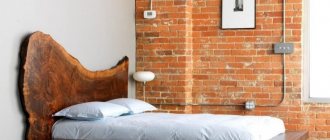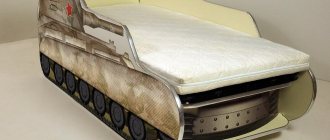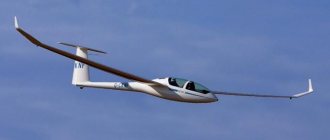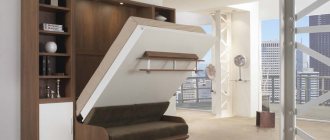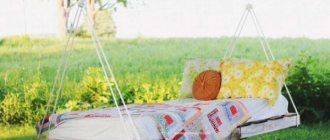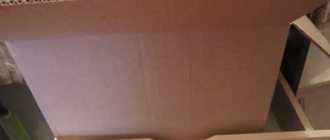Most pieces of furniture have undergone many changes over their centuries-old history and acquired the most comfortable shape, graceful shape and optimal functionality. This is especially true for upholstered furniture - armchairs, sofas, beds. Their configuration and proportions have long been verified and do not require any changes. All options for any innovations relate mainly to design and style, without affecting the furniture construction scheme itself. As for beds, all the options for changing the design are different shapes and types of headboards, since no significant actions can be done with the bed; it is not very suitable for introducing your own ideas. Moreover, spring mattresses that have a standard shape and size are most often used as a soft element, which forces the bed configuration to be adjusted to them. But relatively recently, a very interesting design option appeared - a floating bed. It represents a fresh, original look at a seemingly old design, making it completely new without changing almost anything. Let's take a closer look at it.
What is a floating bed
The inventor of the floating bed is Italian designer Daniel Lago. The model he created is called Fluttua (float). The idea turned out to be so successful and capacious that it instantly aroused the interest of all users who had ever seen it. At the same time, only imported and very expensive samples are available for sale, which has caused a wide wave of self-production of such beds by home craftsmen.
A floating, or, as it is also called, a flying bed is a structure in which the supporting parts are not visible. When you look at it, you get the impression that the trestle bed is “hanging” in the air, without anything resting on the floor. This feeling is erroneous; of course, there is no contradiction to the laws of physics here. Simply, the supports are hidden under the bed in such a way that they are not visible from under the bed, making it look like it is hanging above the floor. The impression is sometimes enhanced by installing lighting from below. It makes a usually dark area brightly lit, which causes a new, completely unusual perception of the usual interior. Externally, even a classically designed bed takes on the features of the Hi Tech style; an ordinary trestle bed looks so technologically advanced and even somewhat surreal. No one has approached the design of an ordinary bed from this angle before, which gives the option additional freshness and originality, allowing you to get powerful motives for decorating the entire bedroom interior with a new approach to the perception of space.
UNUSUAL HOMEMADE BED WITH YOUR OWN HANDS - HOW TO MAKE IT?
You can give your bedroom an unusual look with a floating bed. And you can do it yourself.
The floating, or “levitating” bed gets its name because its support points are not visible. It seems as if the furniture is literally hovering above the floor. However, the feeling of fragility is deceptive - the bed is very stable and reliable. The support is right here. It’s just that it’s small in size (relative to the bed itself) and is located so that you can notice it either from a great distance or by looking under the bed.
I’m not a professional carpenter, but I decided to try my hand at making a floating bed measuring 200x180 cm. I looked at all the available materials on the Internet, took a screwdriver, a drill and a jigsaw, the boards were already in stock, I bought only the missing parts, and the work began!
EVERYTHING YOU NEED FOR THIS ARTICLE IS HERE >>>
Design Features
The design of the bed is a plane on which the mattress lies, supported by supports hidden under it. Depending on the size of the room, the depth of the supports, counting from the outer edge, should be 300 mm or more. This is the difficulty of using a bed of this type - quite large levers appear along the entire perimeter, except for the headboard. Conventional installation on the floor without fixing it to the wall and floor is not suitable in this case. It is necessary to firmly fix the headboard to the wall and the support box to the floor, for which anchor bolts are used.
The frame-box into which the mattress is placed must be assembled with a high degree of strength, since the loads it experiences are significantly different from those that occur on traditional foundations. The usual solution is to create a massive headboard with bedside tables or shelves combined into a single unit. It is attached to the wall and serves as the basis for the cantilever mounting of the box. Depending on the material used, one support can be created in the center of the bed (at the point of intersection of the diagonals). At the same time, it must have a base with sufficient area so as not to create too much pressure at one point. This option is acceptable when using a metal frame assembled for welding or bolted connections.
If wood is used to create the frame, then another design option is used, in which a support box is first assembled, on which the frame is installed on top. The difference in frame and support dimensions is about 300 mm on all sides except the headboard. If you make the box smaller, the overhanging edge of the frame will be too large, creating excessive leverage and requiring reinforcement of all bed components.
Advantages and disadvantages of a floating bed
The advantages of a flying bed are:
- High decorative qualities, unusual and attractive appearance.
- A full-fledged sleeping place that has all the necessary qualities to perform its functions.
- Strong fastening to the wall and precisely calculated location of the supports, ensuring the stability and reliability of the bed, are combined with the appearance of a lightweight bed suspended above the floor surface.
- Wide variety of design options.
- Possibility of self-production. A DIY floating bed is a completely possible and affordable option.
There are also disadvantages:
- Tying the bed to one place creates difficulties when rearranging furniture. In order to change the order of furniture in the bedroom, you need to attach the bed to the wall and floor, which will require some effort.
- Installing a bed is not accessible to everyone; many owners have to turn to specialists.
- The traditional drawer for linen or other things found at the base of a regular bed is either completely absent in such designs or has limited, relatively small dimensions.
Another disadvantage is the lack of complete rigidity, which is especially noticeable in models that have a cantilever mount to the wall with the support far removed from the floor. The edges of such a bed are a little springy, which for some causes psychological discomfort. When choosing such a design for yourself, you should know and take into account all the existing shortcomings in order to be prepared for their presence and be able to successfully deal with them.
What is
A sleeping bed suspended in the air, despite the apparent weightlessness, is a strong, reliable, stable product. The flight effect is created due to the absence of the usual legs. A single leg is used as a support, which is invisible under the bed. The LED lighting located under the sleeping bed gives the product a beautiful look. Furniture with a unique design has its own pros, cons, and features. Modern models are characterized by the following advantages:
- Original stylish design. After installing the product in the bedroom, its interior will become unusual.
- Comfort. As a rule, such beds are made with a large sleeping area.
- Fastening strength. The product is simultaneously attached to the wall and floor, so it does not wobble.
- Availability of space under the bed. A mop can easily clean hard-to-reach areas.
If desired, you can make an original piece of furniture with your own hands from inexpensive materials according to individual sizes. However, the unusual sleeping bed has some disadvantages:
- complex manufacturing, requiring certain skills in working with wood, plywood, metal;
- lack of drawers under the bed for storing things;
- difficulties when moving furniture to another place.
But these shortcomings are fully compensated by the beauty and originality of the item for sleep and relaxation.
What materials can be used to make a floating bed?
To make a bed of this type the following can be used:
- Wood.
- Square metal pipe, another type of metal profile.
- Combined materials.
To create a flying bed at home, using wooden parts is most convenient. They are easy to cut, connect and adjust to each other. In this case, hardwood must be used, and the quality of the material must meet humidity standards. Screws or furniture bolts are used for assembly. The degree of strength of wooden structures directly depends on the quality of assembly, the accuracy of fitting of parts, and the level of materials used.
Making a bed from metal will require welding. You can try to make do with bolted connections, but this option is used only if welding is unavailable. The stronger the connection of all parts, the more reliable and durable the entire structure as a whole will be. Welded and bolted connections can be combined, this will make it easier to transport or move the bed inside an apartment or house.
Combining metal and wood elements will reduce weight and simplify the assembly of some elements. The use of a more rigid and durable metal for the most critical areas is complemented by relatively light and easy-to-process wooden parts, allowing you to solve many issues that arise when making a bed yourself.
In addition, sheet materials (chipboard, MDF, plywood, etc.) are used in production, with the help of which the plane of the bed is strengthened, the side walls of the frame, the headboard and bedside tables or shelves are formed. You will need polyurethane foam to make a soft headboard (if you decide to make one), upholstery material for the headboard and mattress cover. The need for one or another material determines the project plan for creating a floating bed with your own hands.
Where to begin
The beginning of all work on creating a flying bed is careful preparation. It includes:
- Choosing a certain type, design solution, option for the appearance of the bed.
- Creating a project, working drawing or product plan.
- Purchase of all necessary materials.
- Purchasing the necessary tools.
At each stage of preparatory work, the final development of the project is carried out, various minor issues arise and are promptly resolved.
Note! The first point that you must begin the preparation process with is the purchase of a mattress. Its dimensions are very important; all working drawings, dimensions of support platforms, and the amount of materials are tied to the parameters of the mattress. Not everyone can make it themselves; most often a finished product is used, and it must be at the user’s disposal by the time work begins.
Choosing a bed design
This moment is one of the most difficult. There are many options, photographs of which can be found on the Internet.
Determining the most suitable one for yourself means not just choosing the most attractive one, but also finding a bed that making your own will not be an impossible task. At the same time, the choice of color, decorative finish, outline of the headboard and other elements of the product that are not related to the design can be almost unlimited and determined only by the personal preferences of the craftsman or the people for whom the bed is intended.
It is not customary to give any advice in this regard, but you can pay attention to some additional elements that decorate the bed and create a special, specific look for it. We are talking about installing lighting under the support frame. A floating bed with lighting significantly changes the interior of the bedroom, placing emphasis on that part of the furniture that traditionally remains in the background. The light spot enhances the effect of floating in the air, creating a somewhat futuristic, fantastic environment.
Important! Installing lighting may require a radical change in the entire bedroom furniture, so the best option for creating a harmonious interior would be to make a bed in an empty room and then decorate it in the desired style.
How to make a working drawing
If all the work is planned to be carried out independently, then it is not decisive in what form the drawing will be drawn up. The main goal that is pursued when creating it is to carefully think through all stages of the work, clarify the dimensions, methods of connecting elements and parts, clarify some points and detect possible errors and miscalculations. It is imperative to draw up the most complete list of necessary materials (indicating their quantities) and tools that will be needed when performing the work. It is necessary to draw the design to scale in order to be able to evaluate your plan from an aesthetic point of view and, before it is too late, make some changes if they are needed.
Attention! Drawing up drawings of parts, the production of which will have to be ordered from specialized organizations, must be carried out in accordance with current technical standards and rules. Otherwise, discrepancies will arise that can lead to the production of inappropriate components and parts.
Drawings and diagrams
The main goals of creating a drawing are to think through all the work, clarify the details that will secure the design and detect potential errors.
The average thickness of the board that will be used for the frame is 5 cm. Construction stores most often sell pine boards. You need to calculate the amount of material (depending on the size of the person).
Attention! The bed can be either single or double. Length calculations are 20-30 cm longer than the height of the person who will sleep (the average bed length is about 2 meters). The same with width (average about 80 cm).
Making a floating bed frame from wood
To create a frame, it is best to use a 50 mm thick edged board. The most common type of wood in hardware stores is pine, so let's look at the process of creating a frame from it. The working drawing, created in advance, contains a specification that indicates the amount of material. In accordance with it, it is necessary to purchase dried pine boards and let them lie in an apartment or house for some time. This is done so that the material can gain the appropriate degree of humidity, since wood has the property of not only releasing, but also gaining moisture from the atmosphere.
What tools will you need?
To assemble a wooden frame you will need:
- Electric hand saw, jigsaw, hacksaw.
- Screwdriver, electric drill.
- Awl, hammer, pliers, screwdriver.
- Ruler, tape measure, square.
- PVA glue, brush for applying it.
- Furniture corners, bolts, screws.
Support box
The support box, hidden under the upper frame, is assembled from boards 20 cm wide. Its length is equal to the length of the mattress minus 30 cm, usually 160-170 cm. Making the box smaller is dangerous; the bed may begin to tip if someone sits on the edge. Connection boards are made with screws; to strengthen the assembly, you can use furniture corners and furniture bolts with M6 nuts. Wooden blocks (bosses) are also suitable, with which the corner joints are reinforced from the inside.
If you plan to use the support box as storage, a drawer for linen or bedding, you will need to make the bottom out of fiberboard. A piece the size of the resulting support box is cut from the sheet and attached to it using small nails or self-tapping screws with a preliminary application of an adhesive layer. On top of the fiberboard along the entire perimeter, you need to attach reinforcing strips that are attached to the box. Inside the resulting box, you can install a jumper that will divide it lengthwise into two parts. It will reduce the size of the free area of the fiberboard, which will create additional reinforcement for it and eliminate sagging under the weight of things.
Frame frame
To assemble the frame frame, you will need to make two long parts and five short ones, equal in length to the length of the spring mattress and its width, minus the double thickness of the boards. Long boards are marked and drilled in two (at least) places along the axes of connecting the crossbars. Self-tapping screws will pass through the resulting holes, which will be attached to the end of the cross member. The diameter of the drill used for this should be equal to or slightly larger than the external thread size of the self-tapping screws; a drill that is too thick will not provide the necessary tightness and immobility of the connection. The frame is assembled using glue, which is applied to the end parts of the crossbars, and self-tapping screws, with which they are immediately attached to the longitudinal slats. When connecting, you need to control the diagonals of the frame using a long strip (this is the easiest way). They should be equal; if this is not the case, you must immediately align the frame and achieve the same size of diagonals. This is done in order to obtain the correct right angle of connection of the frame, otherwise the mattress laid on it will not fit the frame in shape.
If you plan to use a linen box, then the middle (central) crossbar is not installed. Instead, two longitudinal strips are made, installed between the internal crossbars with a distance between them equal to the width of the support box. All connections are made in the same way as before - using an adhesive layer and self-tapping screws.
Attention! The use of additional reinforcement in the form of an adhesive layer is often ignored. Some masters consider this operation unnecessary and not giving any effect. However, it is strongly recommended not to neglect the possibility of strengthening the frame and frame, since wood has the ability to “breathe”, i.e. collect and release atmospheric moisture, which gradually weakens mechanical connections. The adhesive layer provides the necessary strength and elasticity to the joints, thereby reducing damage from wood movements.
A layer of sheet material (plywood, chipboard, OSB, etc.) is installed on top of the frame, reinforcing the frame and providing a more even support platform for the mattress. The use of a linen box can be ensured by cutting a hole in the center of the sheet material equal to the size of the storage and installing a lid covering it on top. It should be borne in mind that using such a box is inconvenient, since each time you have to remove the mattress, so most often they refuse to make it. It is much more convenient to use various chests of drawers or cabinets that do not require any additional actions.
The first element - the base of the bed - is assembled
To make the lower part (support of the floating bed), I needed 2 boards measuring 1920x200x25 mm, 3 boards measuring 960x200x25 mm and 2 boards 1010x200x25 mm. There was no 200 m wide board available, so we had to make it composite, from two 100 mm boards.
On a flat surface, I began assembling according to the drawing made in advance. In the right places in the boards I drilled holes for self-tapping screws. To prevent the stock from creaking in the future, I coated all joints with silicone glue.
IMPORTANT. Unfortunately, such glue was not enough, so I laid thick polyethylene on the horizontal joints. During operation, it became clear that modifications with glue and polyethylene turned out to be very effective. For two years - not a single squeak!
Then I checked the diagonal with a tape measure. Everything turned out to be accurate. For additional strength, the corners of the base were reinforced with additional posts.
For the top of the bed I needed 5 bars measuring 1710x100x50 mm, 2 bars each 2010x100x50 mm and 350x 100x50 mm, 5 bars 560x 100x50 mm and 3 boards 560x100x25 mm. I used 400x100x25 boards to secure the stock to the base.
I pre-connected blanks 560x100x50 mm with 350x100x50 mm in the shape of the letter “T”. Next, from bars 2010 mm and 1710 mm long, I assembled a rectangle measuring 2010 × 1810 mm.
To hold the diagonal, I attached tie boards to the corners of the rectangle. I drilled holes in the boards ahead of time, but did not connect the parts yet.
And finally, I connected the parts according to the drawing, starting with 560 mm long bars and “T” blanks. Let me mention again: I coated all joints with silicone! It ended up taking several hours to assemble the bed frame.
It's time to make the headboard. I decided to decorate it with a carriage tie. This is a popular technique for decorating upholstered furniture; it got its name due to the fact that it was originally used for the interior decoration of carriages.
On an OSB board measuring 1810x1000 mm, I marked a grid with a side length of 200x215 mm. This made it possible to identify and drill the places where the buttons were attached. Then I transferred the drawing onto a sheet of special furniture foam rubber (density 25) and glued it to the OSB using PVA-M Extra glue. From below I left 300 mm of the slab, not sealed with foam rubber.
Then I covered the headboard with fabric. I started laying it from the top corner.
I’ll warn you right away: when determining the size of the canvas, you need to make a reserve - about 40 cm on each side. Then I installed buttons in the right places using a thick furniture needle.
I secured the threads on the wrong side with a furniture stapler. And later I used it to secure the edges of the fabric.
The lower indentation of 30 mm, which was left without foam rubber, was also covered with fabric. It took about a day to complete the headboard, taking into account the glue drying.
Expert opinion
Smirnova Ekaterina Anatolevna
7 years of experience in interior design, professional architect
The final stage is assembling the bed. I installed the base and upper part of the bed in a permanent place and connected them using small boards.
IMPORTANT. If you have animals (cats), you need to close all the holes inside the base of the bed.
I screwed an OSB sheet on top, but I recommend using natural wood (without glue) or an orthopedic base. The base was leveled relative to the headboard so that the foam was raised above the base by 200 mm, that is, to the height of the mattress.
The sides of the bed were decorated with panels (shelves) made of chipboard. For this purpose, in a large furniture store I bought furniture shelves measuring 2700 x 300 x 16 mm (4 pcs.) and 1200 x 300 x 16 mm (6 pcs.), as well as a 19 mm wide melamine edge strip with an adhesive layer.
IMPORTANT. It was not possible even to very carefully cut through the laminated chipboard panels with a jigsaw without “casualties”: there were still several chips in the coating. To minimize this effect, you need to take special files for laminated chipboard (with small, non-directional teeth). So if you do something similar, it is better to cut the slab on a machine or in a specialized store.
I glued the edge strip onto the laminated chipboard cuts with an iron, through cotton fabric, cut off the excess and sanded it.
I fixed the panels with a clamp (there was no assistant) and drilled holes with a 5 mm confirmat drill (Euroscrew), made a 6.3x50 mm HEX screw tie (100 screws were needed). These screws have a special pitch and cutting angle, which increases the reliability of the connection.
From the remnants of chipboard I assembled shelves behind the head of the bed. They provide additional counterweight for better stability of the bed, as well as a large top shelf and 3 small side shelves for placing interior items and storing things and bed linen.
Making a floating bed frame from a metal profile
A metal frame is much stronger, more reliable than a wooden one, it is less bulky and can carry a larger load. To create a frame, you will need a welding machine, since bolted connections in this case are inconvenient and require a lot of labor. The most convenient material to use is a rectangular steel pipe; it has flat edges, which allows you to tightly connect the parts without additional processing.
Required Tools
- Grinder with cutting wheel.
- Electric drill and drill set.
- Welding machine and electrodes.
- Tape measure, ruler, square.
- A pencil or piece of chalk for marking when cutting.
- Clamps for securing parts to the base for precision welding.
Manufacturing procedure
First of all, you need to assemble the frame frame. To do this, you can cut two long pieces of pipe along the length of the mattress, and several short ones (the width of the mattress minus double the thickness of the pipe). They are welded on a flat plane so that the manufactured frame does not have distortions. It is necessary to monitor the dimensions of the diagonals so as not to warp the frame. The fully assembled frame must be cleaned of burrs, metal deposits that may occur during welding, and sharp edges formed when cutting the pipe.
The second step will be to assemble the support. It can be either one node located along the central axis of rotation of the frame (at the point of intersection of the diagonals), or several supports located deep under the frame (in this case, the optimal distance from the outer edge of the frame is considered to be 30-35 cm). One central support gives a reliable feeling of the structure “hovering” above the floor, but requires a fairly large platform that is screwed to the floor. Four vertical strips are welded onto it, creating the height of the bed, and several jibs - inclined strips, creating rigidity of the structure. It is not recommended to connect such a support to the frame by welding, as it will interfere when carrying or transporting the frame. It is better to use a bolted connection.
Important! Both metal and wooden frames must be coated with a protective layer of paint or varnish, which can reduce the absorption of atmospheric moisture by the wood or protect the metal from corrosion.
Headboard and bedside tables
The headboard for a floating bed is made as a separate block, rigidly attached to the wall. A frame frame is attached to it, which ensures the stability and immobility of the structure. The usual appearance of this unit is a headboard the width of a bed and two shelves on the sides that act as bedside tables. As an option, you can make two hanging bedside tables that do not have supports, which will create the effect of matching the flying bed. The cabinets can be made and installed separately or combined with the headboard into a single unit; this is decided by the owner himself based on his own preferences.
Making a headboard is not very difficult. The main task is the decorative design of the front panel, which can be made in various stylistic options. A variety of materials and colors are used. The selection criterion is usually the resistance of the material to abrasion and contamination, since cleaning the headboard is not always possible. If you use fabric with a soft layer of polyurethane foam installed underneath, cleaning it will become problematic, so you will have to constantly monitor the cleanliness of the front panel. Recently, panels made from wooden planks or artificial imitation wood, without upholstery fabric, have become widespread. This option will allow for periodic cleaning of the headboard, but the surface itself is hard, which is not the best solution for a bed.
Important! When designing the headboard of the bed, you should take into account the color and material of the rest of the furniture in the bedroom. This way you can create the most harmonious atmosphere in the room.
The headboard is mounted to the wall using anchor bolts. Their number is determined by the type of bed support, but should not be less than 2. It is advisable that the headboard has additional support on the floor, this will help reduce the load on the wall and distribute it more evenly.
Drawing up a design project
Before work, you need to prepare a drawing of a floating bed to make yourself. First, you need to decide on the dimensions of the furniture being created, select the necessary material, decide which parts will be included in the design, and clearly imagine the appearance of the future product.
If you do not have sufficient experience or the necessary equipment, then some of the parts should be ordered from specialists. This applies to metal supports and the frame of the product. Along with the materials, it is necessary to give the master detailed drawings, which must be made in full accordance with the standards of the future product.
The first stage is to view photos of finished models and select the appropriate option. Attention should be paid to the materials from which the furniture is made, dimensions, and additional elements used for decoration. To determine the dimensions of an unusual design, you need to make accurate measurements of the room in which the bed will be installed. Then you need to choose a mattress, the dimensions of which will also determine the design of furniture with the levitation effect.
After determining the width and length, the issue of the dimensions of the support is resolved. It is better to look at the furniture from the greatest distance and make a sketch. Only then can you finally choose the size of the support and decide how much smaller it should be relative to the main part of the structure. Please note that the support should not be narrow, otherwise the bed will sway.
There are model options that do not require support. In this case, the flying structure has a thick headboard and an L-shaped steel pipe, a short section of which is firmly fixed to the wall. The frame is made strong enough not to wobble or break even when sitting on the edge of the bed. It is possible to manufacture an intermediate version with a smaller support made of high-strength transparent, almost invisible material.
Then the configuration and size of the headboard is selected, which is one of the main parts of the structure and determines the design of the bed. The color of the product and decorative elements are considered. Next, a diagram of the floating bed is drawn up, structural elements, connections, and parts used for reinforcement are worked out. During the work process, you need to check the results more often, measure parts several times in order to eliminate possible errors at the initial stage, and not at the end of manufacturing the product.
The drawing is drawn up both for the entire structure and for the parts. For precise manufacturing, not one, but several projections are performed. Once you have completed drawing the plan, you can begin purchasing materials and tools.
Backlight installation
LED strips are used for illumination. They are safe, have a lot of options for choosing colors or brightness levels. They are installed from below on the back wall of the decorative trim of the frame. The main condition for the effectiveness of the lighting is the complete invisibility of the tape from the outside, so that only the illuminated space under the bed can be seen. Installation is carried out on the sides and under the footboard; installing the tape under the headboard does not make sense - this space is not visible, and the side areas sufficiently illuminate the space visible from the outside. To attach the tape, the manufacturers provide an adhesive layer on the back side, so installation will not create any problems. You will need to remove the protective film and simply stick the tape around the perimeter of the inside of the decorative frame. If the condition of the surface does not allow the tape to be firmly attached (the surface is rough or has a noticeable relief), then the connection should be strengthened with glue. You can use “Moment” glue, gel second glue, transparent thick “Titan”. These materials are suitable for attaching the tape to almost any surface and will ensure reliable fixation.
More detailed or visual information can be obtained in various videos, of which there are many on the Internet, for example:
A flying or hovering bed, created with your own hands, will save a significant amount of money and create a unique, magical interior in the bedroom. To make it, you will not need any specific tools or materials, but you must have skills and experience working with wood or metal, otherwise the quality of the product will be low. Design skills also don’t hurt, although there are many design options for such beds online, you can choose any one you like. All materials needed for the work are commercially available and quite affordable. Prices for materials are relatively low, in addition, there is always the possibility of choosing materials of one or another price category. All that is required from the master is his experience, diligence and patience, which will certainly be rewarded and will be able to create a cozy and comfortable environment in the bedroom.
Bed lighting with LED strip
An LED strip is a board with LEDs placed on it. It also has its pros and cons. The advantages include the following:
- easy installation due to the adhesive layer;
- ease of use, compactness;
- the price is lower than for duralight.
Flaws:
- low moisture resistance;
- lack of protection from mechanical damage.
Most often, LED strip is used to illuminate the bed. Now let's look at the installation methods step by step.
